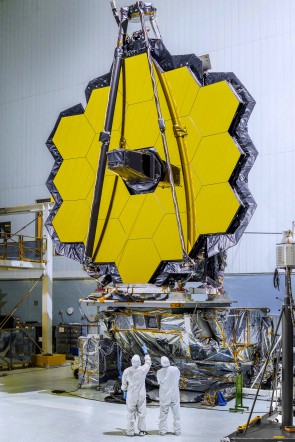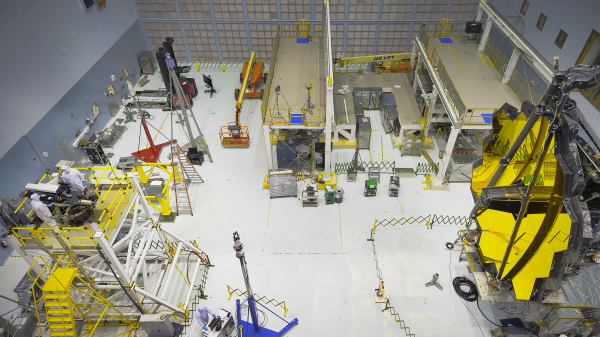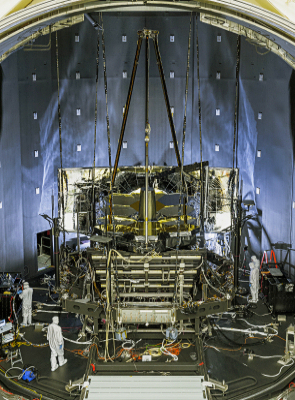#11: Preparing for the ride to space
21 December 2016
In the second half of 2016, the James Webb Space Telescope (JWST) was readied for an intensive series of environmental tests, an essential step in ensuring that it will survive the stresses of launch and complete its groundbreaking survey of the infrared sky. |
| JWST's combined Optical Telescope element / Integrated Science instrument module (OTIS). Credit: NASA–C. Gunn |
After integration of the combined Optical Telescope element / Integrated Science instrument module (OTIS) was completed in the summer of 2016, it was subjected to an extensive "pre-environmental", warm functional test campaign.
These tests were called the WIF (Warm ISIM Functional) and WOF (Warm Optical telescope Functional). Both tests took place at "normal" temperature and checked all the electrical connections, settings and functionalities of the various subsystems that are on OTIS. The same test campaign will be repeated after OTIS undergoes launch environment tests.
Accurate measurements of the main structural elements of OTIS were made during the autumn, in preparation for a series of launch environment tests that were to begin later in the year.
Once these vibration and acoustics tests are completed, the measurements will be repeated to verify the integrity of the structure. Making the same optical measurements before and after the simulated launch environment testing and comparing the results is fundamental to JWST's development, assuring that it will work in space.
This "optical metrology" involved the use of laser and radar tracking equipment to make extremely accurate measurements of the main structural elements on OTIS.
Typically accurate to within 35-40 microns (about the width of a human hair), the measurements established the positions of a large number of critical reference points on the OTIS and confirmed whether anything had moved as a result of the extreme environmental conditions. The test data confirmed that the OTIS was ready for integration on the back of the telescope.
 |
| JWST centre of curvature test. Credit: NASA–C. Gunn |
Particularly challenging in this respect were the "centre of curvature" measurements conducted at NASA's Goddard Space Flight Center (GSFC) in Greenbelt, Maryland. To perform these tests optical engineers set up a specially designed interferometer, an instrument capable of measuring the shape of JWST's primary mirror with incredible accuracy.
Since waves of visible light are less than a thousandth of a millimetre long, the telescope's optics need to be shaped and aligned even more accurately than this to work correctly. Using beams of laser light to make measurements of the mirror shape and position prevents physical contact and damage (scratches to the mirror). By using an interferometer to measure light reflected off the optics, scientists can measure extremely small changes in shape or position.
During the test, temperature and humidity conditions in the cleanroom were kept as stable as possible to minimise drift in the sensitive optical measurements over time. To avoid tiny vibrations in the cleanroom that could cause jitter during measurements, the 'high-speed' interferometer was designed to take 5000 'frames' every second - faster than the background vibrations themselves. This allowed engineers to subtract out jitter and obtain good, clean results.
OTIS is the largest space flight payload tested at GSFC to date, so a new shaker system had to be specially built. This shaker system is needed to conduct the vibration tests, part of the launch environment campaign. During these tests, the vibrations that the payload will experience during a launch aboard the Ariane 5 rocket are simulated.
In November, in preparation for the environmental campaign, a special "tent" was built and placed around the payload to ensure that OTIS would not be contaminated by dust or dirt during the vibration and acoustics tests.
 |
| Thermal test of the JWST Pathfinder structure. Credit: NASA–C. Gunn |
Meanwhile, the JWST Pathfinder structure was placed in the giant cryovacuum chamber at Johnson Space Center, prior to commencement of a series of temperature and vacuum tests similar to those that the actual JWST telescope will have to pass in spring 2017. The Pathfinder is a test version of the structure that supports the real JWST telescope.
The giant test chamber, which was built during the Apollo Moon programme, has been refurbished specifically to test JWST. These tests are intended to spot any potential problem with the test equipment and procedure, thereby minimising the chances of delays with the actual space observatory.
Excellent progress is also being made with development of the huge sunshield that will protect JWST from background heat from the Sun that would interfere with the telescope's infrared sensors. The fifth and final sunshield layer was completed in September. The size of a tennis court, the sunshield, along with the rest of the spacecraft, will fold origami-style into the fairing on top of the Ariane 5 rocket that will blast JWST into space.
 |
| Final sunshield layer completed for JWST. Credit: Northrop Grumman |
Integration of OTIS, the sunshield and the JWST spacecraft is scheduled for early 2018.
About JWST
The James Webb Space Telescope (JWST) will be a general-purpose observatory with a 6.5-metre telescope optimised for infrared observations and a suite of four astronomical instruments capable of addressing many of the outstanding issues in astronomy. The primary aim is to examine the first light in the Universe – those objects which formed shortly after the Big Bang. Further aims include: looking at how galaxies form; the birth of stars; and the search for protoplanetary systems and the origin of life, including the study of exoplanets. JWST is a joint project of NASA, ESA and the Canadian Space Agency. It is scheduled for launch in 2018 on an Ariane 5 and will operate approximately 1.5 million kilometres from the Earth in an orbit around the second Lagrange point of the Sun-Earth system, L2.




